S&J Hardware MK II +2 Extension Kit Review
Thanks to Synchronizor for this review
S&J Hardware (http://www.sjhardware.com) is a Canadian manufacturer & retailer of firearms accessories and other shooting-related products. They offer a number of add-ons and replacement components for shotguns, including a line of magazine extensions for the Remington 870 and others. A lot of S&J Hardware’s products have proven popular in the 870 community, such as their magazine followers and Velcro shell carriers, and I’ve personally used several of their accessories for years with good results. Their magazine extensions always sounded really good on paper, but I really hadn’t seen them in the wild much, and had no personal experience with them. This came up in a discussion on the Rem870.com forums, and soon afterward, Scott Mueller, S&J’s United States distributor (http://www.sjhardware.us), contacted me asking if I would be interested in having one sent over for evaluation. Obviously I was interested.
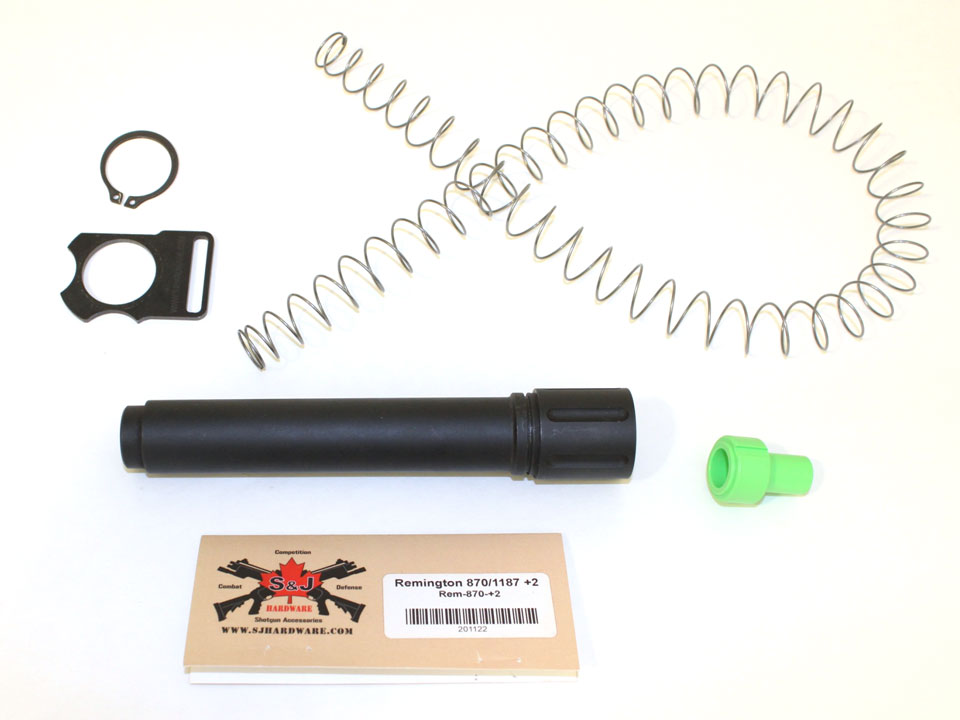
S&J Hardware MK II +2 Remington extension kit
The kit being evaluated here is a +2; S&J also offers +1 and +3 extension kits for the 870. This extension is a MK II version; a relatively recent update to the original S&J extension design.
Extension Design & Construction:
The S&J Hardware extensions are single-piece designs, meaning that the extension itself – not counting the sling plate or internals – is a single item that installs just like an elongated magazine cap. I explain the differences between single- and two-piece extensions in more detail in the video below:
The S&J Hardware extensions are monolithic; the entire extension is machined as one part from a single piece of 4140 chromoly steel – a common and popular alloy for structurally demanding applications that offers a good balance of strength, and resistance to impact, wear, & fatigue. Unlike composite extensions that consist of multiple permanently-attached components, a monolithic extension has no joints that could potentially fail due to manufacturing defects, severe impacts, or corrosion. And without the need for different parts to overlap and provide enough surface area for a strong joint, a monolithic extension can be lighter and/or more streamlined. While the benefits of monolithic extensions are often over-stated (especially with regards to attributes like dent resistance, where monolithic & composite extensions are typically on pretty even ground if made from similar materials), monolithic construction is a nice feature for an extension that may see rough use, even more so if it’s taken advantage of to improve other attributes like weight or capacity.
The extension’s cylindrical base is 1.26” long and 1.23” in diameter. There are 6 flutes machined into this base that remove some weight (roughly 1/3 of an ounce by my estimation) and provide some grip for installation and removal. This gives a distinctive look to the S&J extensions, making them stand apart from the many others that have knurled bases. The original S&J extensions had knurled bases as well; S&J have indicated that this fluting and other changes have helped to make the newer MK II extensions easier and less expensive to produce.
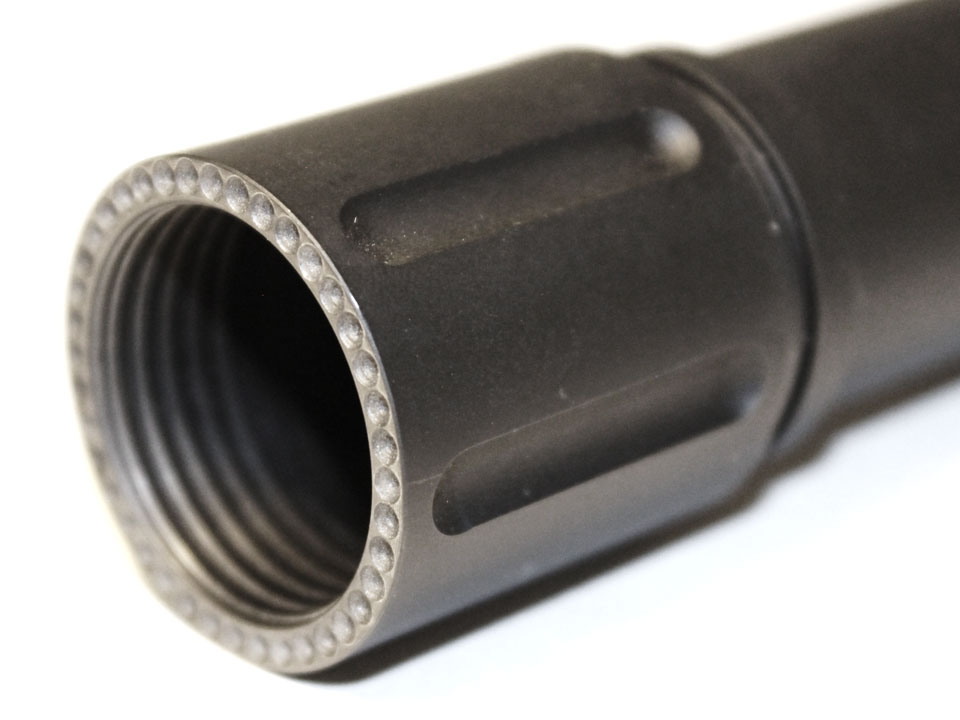
S&J Hardware Extension Base
The bottom end of the base is machined flat, and dimpled to engage magazine cap detents on barrels that feature them. The dimples are tightly-packed so that there’s essentially no space between them where a detent wouldn’t engage. Trying it out with my two barrels that feature mag cap detents, it seems that these dimples are placed slightly further inward than ideal due to the fairly narrow diameter of the base (many mag caps and extensions have rims or bodies that are wider than the guide ring to ensure engagement with the mag cap detent). The dimples just barely manage to engage the detent on one of my barrels, but my other barrel’s detent is too far from the magazine axis, and there are no tell-tale clicks when the extension is tightened down.
Inside, the extension’s base can accommodate well over half an inch of the threaded end of a magazine tube, more than is really needed for properly-made 870s and clones, which usually only have around .3” of thread extending past the barrel guide ring. Such an excessive amount of thread in a single-piece extension is often concerning, as it tends to suggest a gap will be left at the joint that could cause reliability problems. However, the S&J extension is cleverly machined here, with the throat of the extension hugging tightly to the minor diameter of the mag tube thread instead of opening up, and then an elongated conical section where the tube shrinks down to its final interior diameter, rather than an abrupt shoulder. This clever interface is very effective at creating a smooth transition for shells and the follower as they pass from the mag tube into the extension without having to depend on the tube being threaded in an optimal amount.
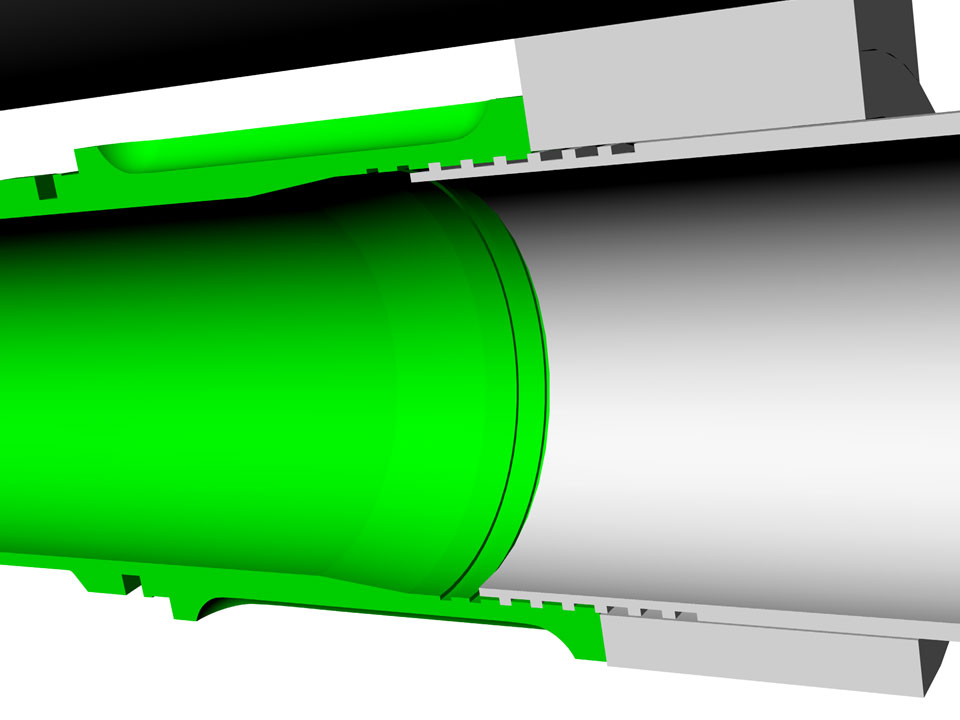
Cross-section of extension throat
Forward of the base, the extension steps down slightly to create a shoulder for the sling plate to sit against, then steps down again to a standard 1” outer diameter for most of the rest of its length. This standard OD makes the extension compatible with a wide variety of clamp-on accessories. The final 3/10” at the extension’s front end steps down further to enable the attachment of M16 bayonets, with the addition of a clamp-on rear bayonet lug. More info on sling plates and the optional bayonet mount later on. In the center of the front end is a vent hole that allows air to move in and out of the tube to reduce pressure drag, provides a point where any water (or other liquids) can quickly and easily drain out, and allows a dowel or rod to be inserted to control and align the magazine spring during assembly and disassembly.
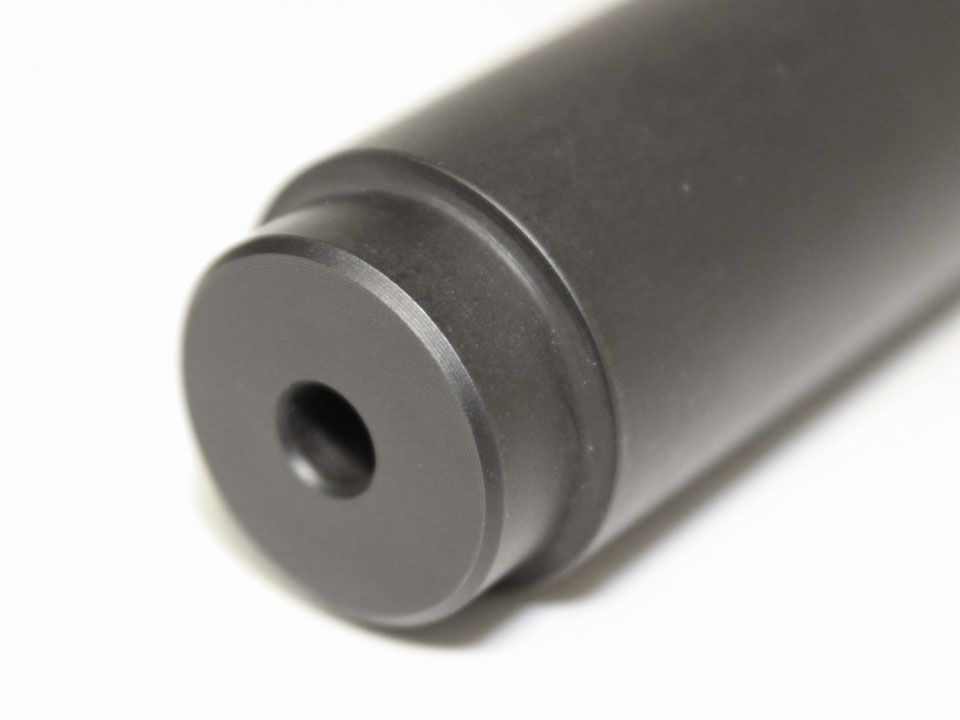
Front end of extension
The interior of the tube shows some leftover machining marks from when the interior was bored out. This doesn’t seem to affect function at all, at least with the included follower, so it’s really just a minor cosmetic issue.
Overall, the extension is just a hair under 6.75” in total length, so when installed on standard 870s with 4-round base magazine tubes, its front end will line up with the muzzle of an 18.5” barrel, or extend a half-inch past the muzzle of an 18” barrel.
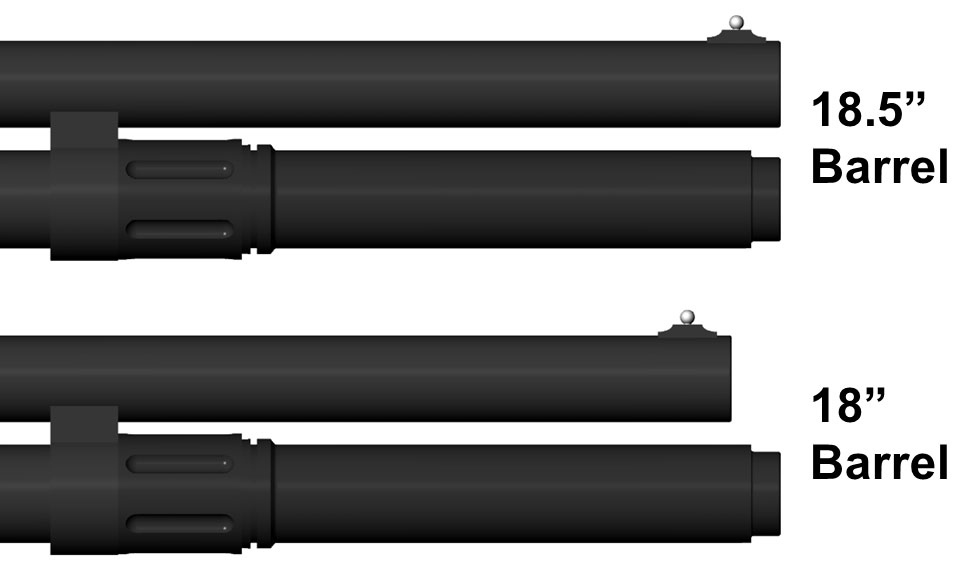
S&J +2 on 18” & 18.5” barrels
This extension can also be installed on 870s with nonstandard magazine tubes & guide ring locations, such as the H&R Pardner Pump 870 clones with 5-round magazine tubes, or the newer 870 Express Tacticals with 6-round magazine tubes. If installed on a Pardner Pump Protector or long-mag 870 Express Tactical – both of which have 18.5” barrels – the S&J +2 should extend about 3 5/16” or 4 3/4” past the muzzle, respectively (not counting extended choke tubes).
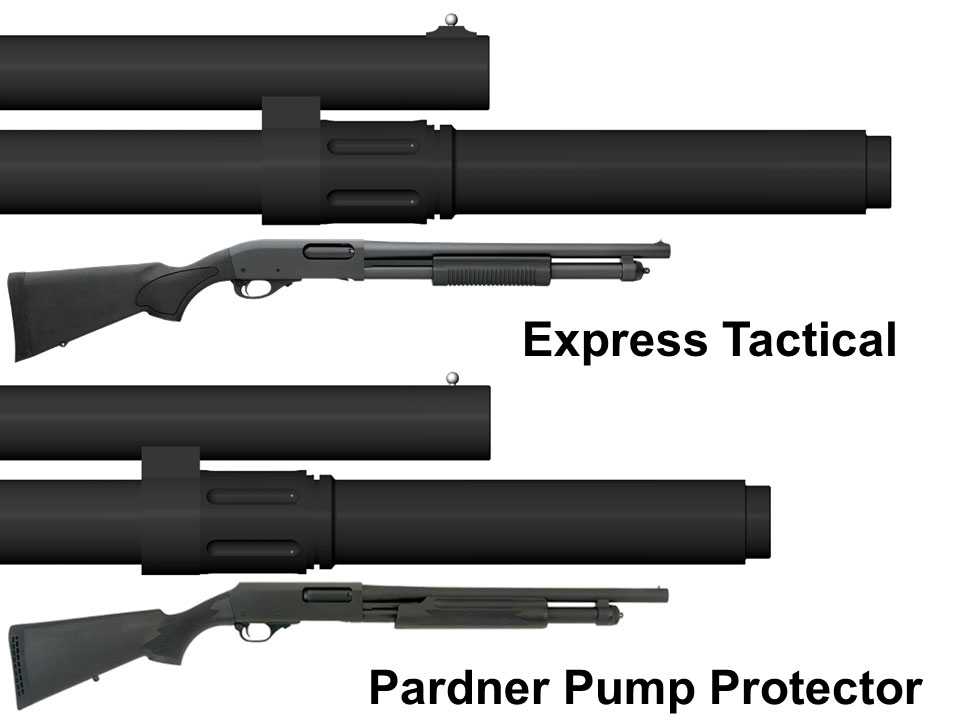
S&J +2 on nonstandard mag tubes
An extension that sticks out past the barrel may look a bit awkward, but it should cause no functional problems while shooting, though the extension might need some cleaning afterwards. It may negatively impact durability in certain rough-use applications, since the extension alone is more likely to take the full force of impacts. If this is a concern, a reinforcing clamp or bracket can be added, or you can look at S&J’s +1 extension instead.
A final note regarding length: since this is a single-piece extension, installing any under-cap accessories beneath the extension will shift it forward by the thickness of that accessory.
Spring:
S&J Hardware extension kits come with a replacement magazine spring. These springs are made from a chromium-silicon steel alloy, rather than the heat-treated 17-7 stainless used for factory magazine springs. S&J springs place emphasis on reliability and high cycle life, which are advantages of a Cr-Si spring. S&J claims their mag springs are capable of working for 600,000+ cycles. Other plusses with this spring alloy include good shock loading tolerance and the ability to handle high temperatures. Cr-Si springs are not typically as corrosion-resistant as stainless, but this shouldn’t be a concern for the majority of users, and 17-7 isn’t exactly impervious either. For real harsh-environment situations such as regular exposure to salt water, a special plated or coated mag spring would be the thing to go for.
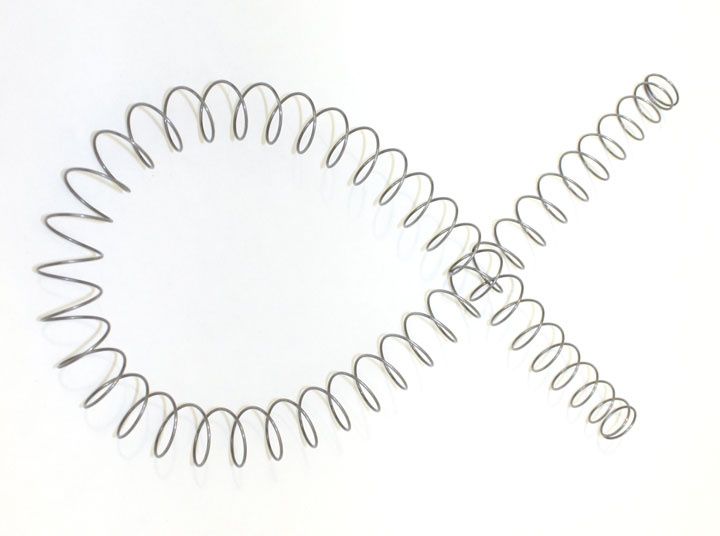
28” +2 magazine spring
These springs use a “beehive” geometry; they have a relatively large OD of .8” that narrows to around .67” at the ends. These smaller end coils help to keep the spring centered on followers with tails. Cup-style followers generally aren’t going to be the best choice for use with this type of spring, as the wide central coils cannot stack up inside the cup.
Earlier S&J Hardware +2 extension kits – including the one I initially received for review – came with a very long 48-inch spring. It was intended that the user would cut this long spring down to match the total internal length of their assembled magazine. I personally like it when extension manufacturers do this, as the spring force can be fine-tuned for a specific application, and it allows the kit to be easily installed on nonstandard 5- or 6-round magazine tubes. However, a lot of folks don’t know all the detailed physics behind springs, and as the kit didn’t come with any instructions or guidelines for trimming the spring, this would be a negative for most people.
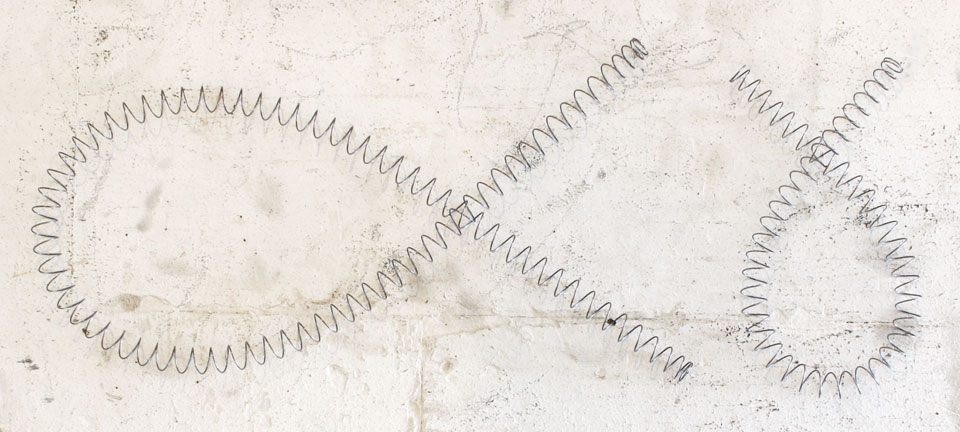
48” and 28” magazine springs
Currently though, S&J MK II +2 870 extension kits are shipping with a shorter 28-inch spring specifically sized for that extension as installed on a standard 4-round magazine tube (although you may still see the longer springs in kits that were put into circulation prior to this change). Scott from S&J USA was kind enough to send over one of these springs so that I could evaluate the extension kit in its current iteration. The 48-inch springs are still available separately from S&J and their distributors if you’re working with a nonstandard receiver or want more spring force, but this review will assume use of the current 28-inch spring unless stated otherwise.
As mentioned, the spring was 28” when new. After some use, it shrunk by a bit over 3 inches, which is typical for initial spring set. With a solid length of about one inch, the spring is fairly space-efficient. In the +2 extension & standard 4-round base magazine tube, and after a good break-in period, it provides about 1 3/4 pounds of force at empty, and 6 1/2 lbf when fully-compressed. This level of force should ensure reliable feeding for most shooting without being heavy enough to make reloading difficult, or deform shells that are kept in the magazine for long periods of time (although checking shells periodically is still recommended if a shotgun is being stored loaded, no matter what magazine setup it has).
Follower:
S&J Hardware extension kits also include a replacement magazine follower, one of their highly-popular “No Jam” followers machined from Delrin acetal polymer. This material is a very good choice for this application, as it is strong, wear & impact-resistant, doesn’t absorb moisture or react to most chemicals, and can be machined to tight tolerances. The specific formulation used here contains a Teflon additive, which makes the material self-lubricating as well. Metal followers can wear or even damage a gun internally over time, and coatings used to add color or increase lubricity can eventually wear or chip off. None of this is possible with homogenous plastic parts. While S&J followers come in several different styles, all feature bright high-visibility colors and a tactile element in the front face, making it very easy to verify whether the magazine is loaded or unloaded by sight and touch alike.
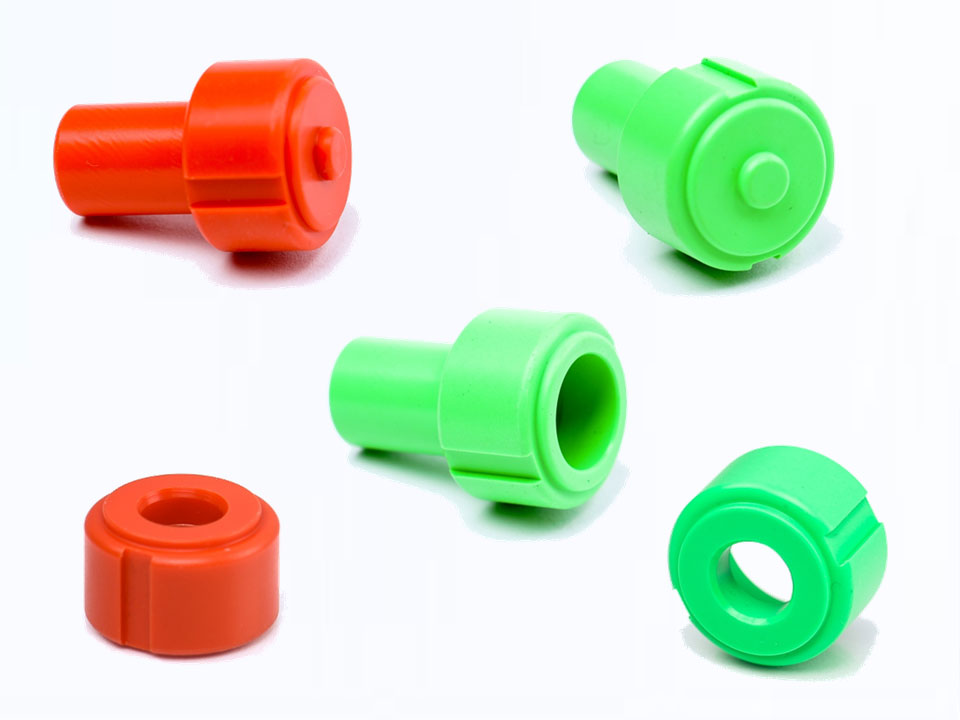
S&J Hardware Magazine followers
I have been a fan of the S&J magazine followers for years, and have used them in a variety of extensions with good results. They offer excellent function and durability thanks to intelligent design, good materials selection, and quality manufacturing; and their safety features are second to none.
The specific follower that came with this extension kit is S&J’s Type 2 follower, which is a solid-bodied, tailed design with a hollowed-out front face for the tactile safety element. I think the Type 2 is S&J’s best follower style for use in most extended magazines. The tail on the rear of the follower keeps longer mag springs aligned while being short enough to not limit capacity, and fits pretty much any spring I’ve tried. The tail does sometimes make loading a bit rough when the spring is nearing the limits of its compression and the coils are stacking up on each other, but it prevents coil bind and always feeds smoothly afterward. The hollow in the front face is quite large, and very effective at making the follower feel different from a shell, even when wearing gloves. It also lightens the follower, and won’t crack open shell crimps like the post on the Type 1 follower can.
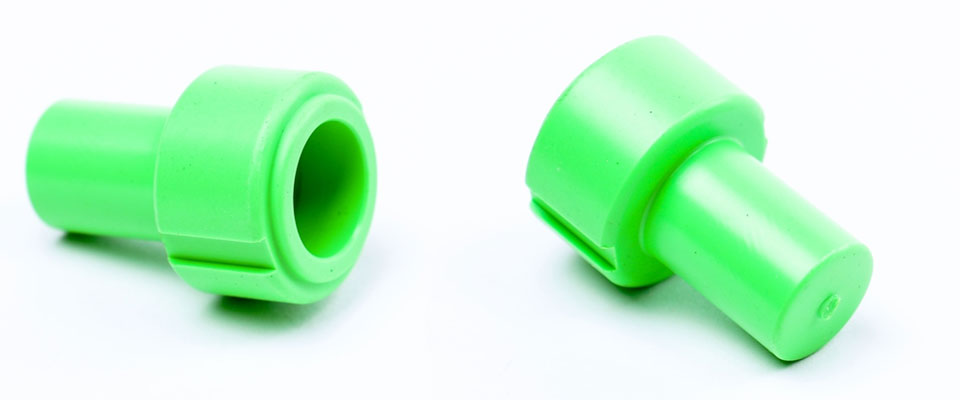
S&J Hardware Type 2 follower
As with all S&J Hardware followers, the Type 2 is slotted to allow it to be installed in dimpled magazine tubes without extensions. However, mag tube dimples will still interfere with shell & follower movement in extended magazine configurations whether the follower is slotted or not, so they must be removed before installing this +2 extension kit.
My one complaint with S&J’s Type 2 follower is that it’s only available in green, while their other 12ga 870 followers can be had in both green and orange. I personally prefer orange, since that color just “pops” a bit more to my eyes; but the neon green is easy to see too – even when dirty – and many folks are sure to like the green as it stands out from the blaze-orange followers seen in most 870s, and gives a shotgun a bit more of a custom look.
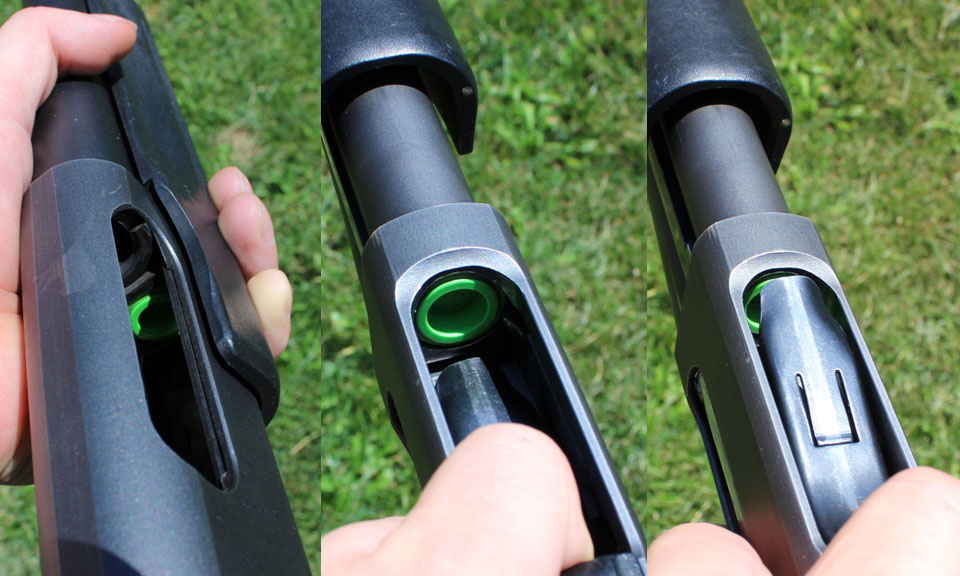
Excellent visibility of S&J Type 2 follower. These pictures were taken after the gun fired over 450 rounds without being cleaned
Capacity:
The S&J +2 has a decent amount of internal capacity, with about 6 1/4” of internal tube space as measured from the extension’s base to the internal end of the tube. Mashed all the way down to full compression, the spring and follower take up about 1.5” of the space in the extension. That leaves about 16.58” of tube space left for shells when this extension is installed on a standard mag tube with a typical amount of thread engagement. This is easily enough space for six 2.75” or 3” shells (2.45” and 2.76” max crimped length respectively, according to SAAMI specs), even unusually-long 3” shells with very shallow roll crimps. It’s also plenty of space to provide a +2 capacity increase with 3.5” shells (3.155” maximum crimped length according to SAAMI), increasing capacity from three to five for SuperMag 870s.

Maximum crimped shell lengths for given magazine capacities
Even better, this extension kit can often accommodate seven 2.75” shells, acting as a +3 right out of the box without any modding or replacement of its internals. This isn’t just with certain target loads with especially deep crimps either, but a wide variety of fold-crimped shells, including many common defense/combat loads like Winchester military 00B, Federal FliteControl buckshot, or Remington Express Buckshot & 2.75” Sluggers. I was even able to squeeze seven in the tube with Remington’s 12-pellet 00B short magnum shells. 7+1 rounds of full-power buckshot or slugs is quite a healthy amount of firepower for a compact 18.5”-barreled shotgun.
If installed on a 6-round Express Tactical or 5-round clone mag tube using a longer spring, this extension should still provide a +2 capacity increase with 2.75” shells, as well as most – if not all – 3” shells. It’s hard to say for sure without knowing what length spring is needed for reliable function with the longer tube.
Please note that capacity can vary with single-piece magazine extensions since the total internal space is directly influenced by dimensional variations and certain accessories. If you want to know exactly how much space you’ll have to work with, you should measure your own shotgun and do the math.
Sling Attachment Hardware:
The S&J magazine extensions come with a three-position sling plate with a loop that allows for the direct attachment of slings up to 1 1/4” wide. This plate is able to rotate freely about the extension so as not to interfere with installation or removal, and is held in place just forward of the extension’s base by an external retaining ring that can be installed & removed using retaining ring pliers. The plate has S&J’s website printed on it, which is something I’m generally not a fan of, but at least it’s subtle.
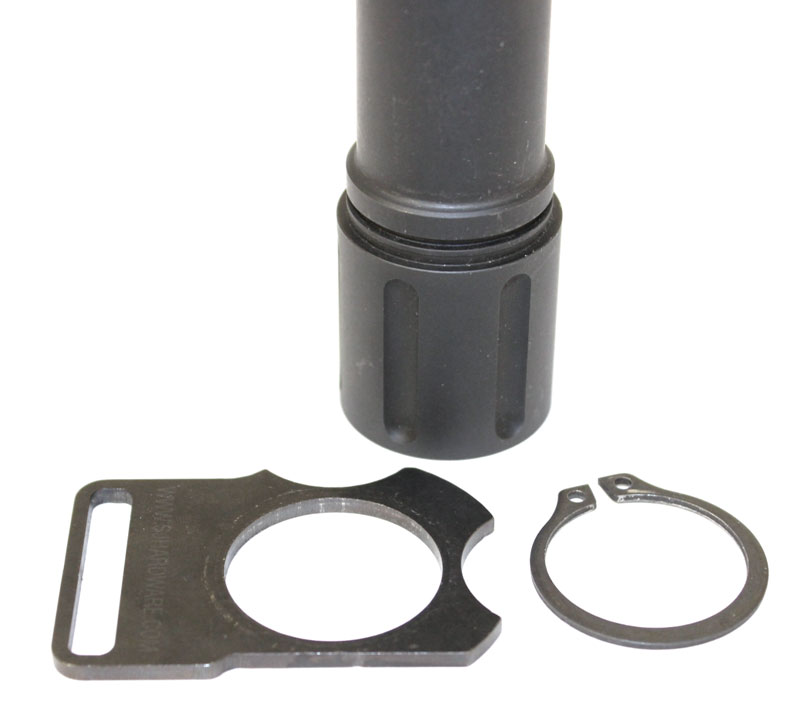
S&J sling plate
When the extension is installed on the gun, the plate is held in its intended orientation by a radiused cut-out that engages the barrel. There are two barrel cut-outs in the plate so that the sling loop can be oriented vertically to match the sling attachment point on most factory stocks, or to the left or right to match a side rear sling point. Because there are only two cut-outs, switching the sling loop from left to right, or vice versa, requires that the retaining ring be removed and the plate flipped around; but switching between a side orientation and the vertical orientation can be done by simply unscrewing the extension and rotating the plate 90 degrees.
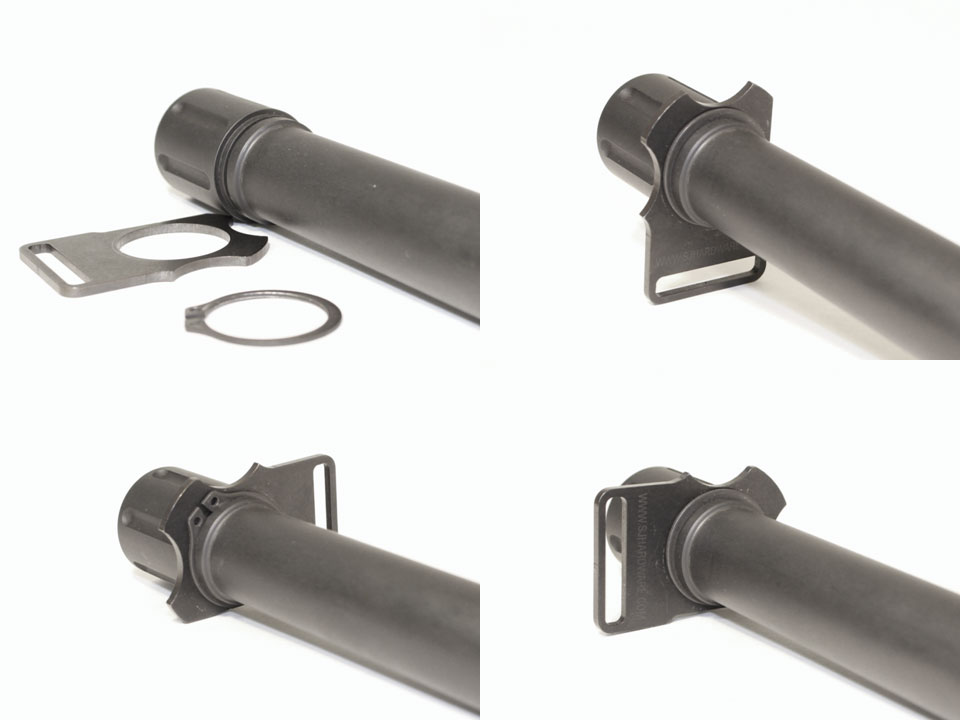
Sling plate in varying positions & off the extension
This sling plate system is very similar to that of the Vang Comp magazine extension, and in fact, the S&J extension can use aftermarket plates designed for the Vang Comp, such as the Mesa Tactical plates that provide round loops for clip- or hook-type quick-detach sling hardware. Custom sling plates are another option. The critical dimensions for custom sling plates are a .1” thickness and a 1.2” – 1.125”- diameter center hole to go over the extension. The barrel cut-out will depend on your specific barrel’s OD & spacing, and how tightly you want it to fit. These would not be difficult to make from scratch for someone with engineering & machining tools, or under-cap sling plates from other manufacturers could likely be adapted, since the plates would still be centered on the axis of the magazine tube. As long as the plate is the right thickness (plates thinner than .1” could also potentially be adapted with the use of shims), all you’d need to do to would be to open up its center hole slightly.
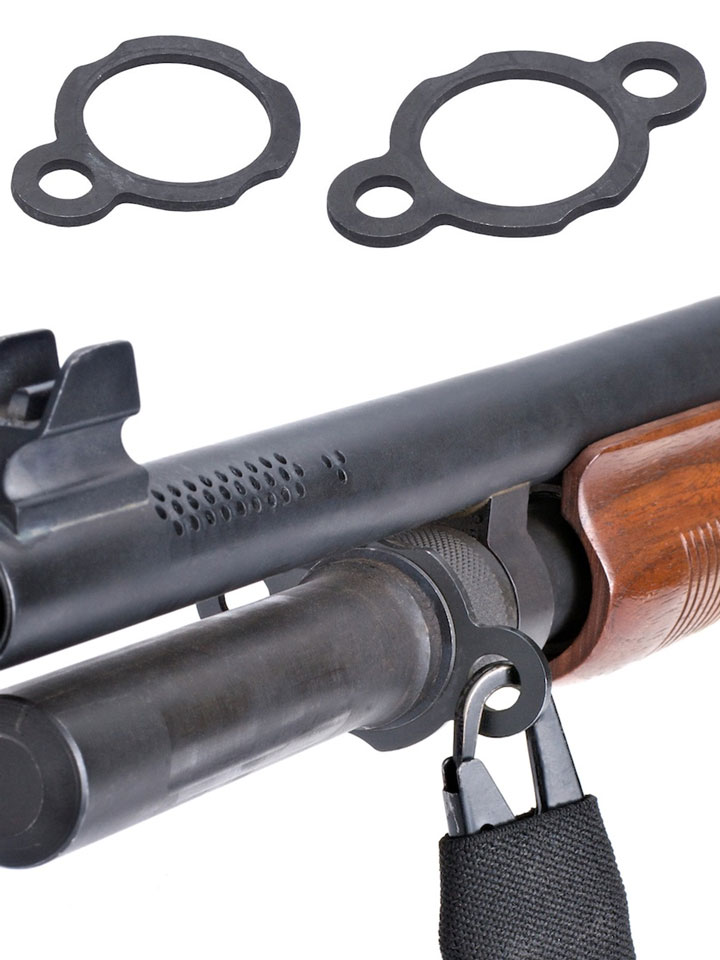
Mesa Tactical clip-style QD sling plates
While the sling plates for the S&J extensions improve upon the Vang Comp plates due to the extra cut-out that allows for a vertical orientation, they share the other major flaw of the Vang Comp plates – very sloppy barrel fit. The barrel cut-outs use a large half-inch radius, which would match a 1” barrel diameter. There are some heavy-wall slug or card-shooting barrels with diameters this large, but these are uncommon, and are rarely paired with a magazine extension anyway. Most hunting and fighting 870 barrels use a smaller OD, and with them, this sling plate has a lot of free play. Now, the plate does still do its job, but the extra play makes noise and would be more prone to damaging the barrel’s finish.
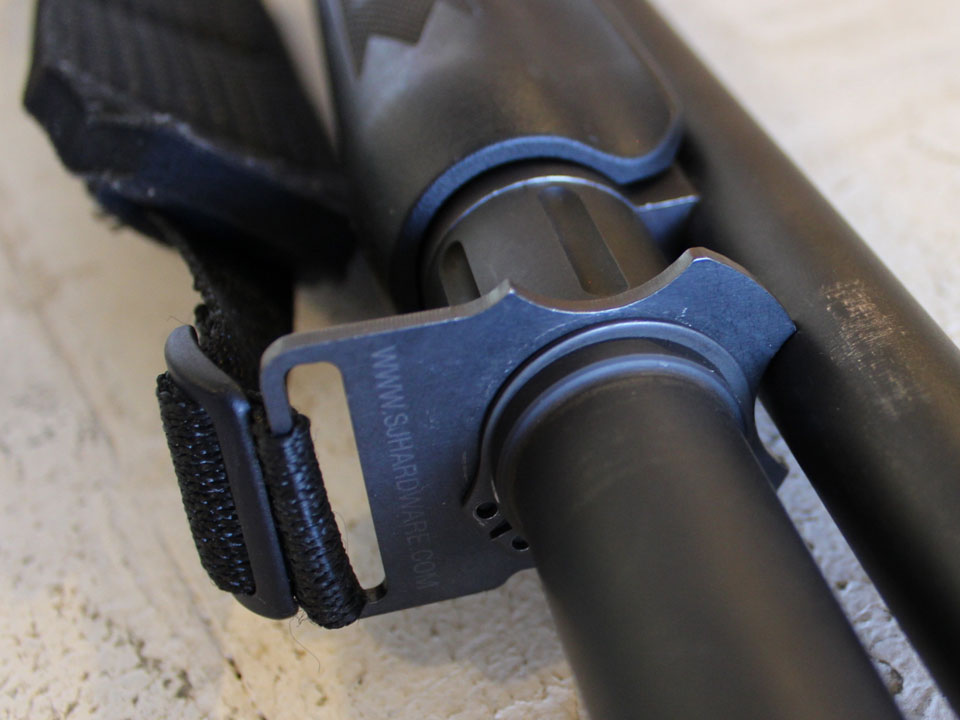
Sling plate fit
I can understand the attraction in having one sling plate that will function with all barrels, but as I said in my Vang Comp review, I feel it would have been better for S&J to design the included sling plate for the standard barrel profiles that are used by the majority of 870s, and then make this heavy-barrel sling plate available for purchase separately.
While we’re at it, I would also really like to see S&J offer a QD version of their sling plate. A simple and straightforward loop is a good choice if the gun will be wearing a sling permanently, but a lot of owners don’t need to keep a sling on their gun all the time, and doing so can be counter-productive for some applications. Depending on the sling itself, undoing the end and getting it on and off a fixed loop can be pretty difficult and time-consuming. It would be great if S&J offered a plate with a QD stud (like the QD sling plates available on the Wilson Combat +2 extensions), so that their customers didn’t have to have something custom-made, or add a separate sling mount from another manufacturer, in order to easily attach & detach a sling.
Weight:
Combined, the S&J +2 extension, 28” spring, follower, and sling plate with retaining ring weigh in at about 8.4 ounces. If you’re not using the sling plate, the kit will be just under an ounce lighter. Going with a longer spring will add a bit more weight; the full 48” spring weighs 1.35 ounces.

Weight break-down for the S&J MK II +2 kit
A typical 12ga magazine cap, spring retainer, 4-round spring, and factory follower weigh roughly 2.2 ounces all together, plus or minus half an ounce depending on the exact components. So expect the S&J +2 extension to increase your gun’s unloaded weight by about 6.2 ounces with the sling plate, or 5.3 ounces without the plate.
As one would expect from a higher-priced, more refined kit, the MK II S&J +2 extension is lighter than less-expensive competing kits like those from Wilson Combat or Vang Comp. It’s not a huge difference, and some of the saved weight in the tube itself is canceled out by the robust spring & machined follower, but considering that the S&J extension is a half-inch longer than those other two all-steel single-piece kits, and is capable of functioning as a +3 with many shells right out of the box, I think it’s definitely ahead of the curve. I could get nit-picky and point out a few areas where small amounts of additional weight could be shaved off, but none of these are glaring design oversights, and most would require additional machining steps that S&J may have decided weren’t worth the time & cost. Obviously, if weight is a real driving priority for you, you’re probably not going to be looking at all-steel extension kits anyway.
Finish:
The S&J magazine extensions have a Parkerized finish, which is a metal phosphate conversion coating that has long been popular on military & law enforcement firearms for its low reflectivity, decent wear resistance, and good corrosion protection – especially when kept oiled. S&J’s website describes this as “mil-spec” Parkerizing, but doesn’t give any details or reference any particular spec. In any case, the finish seems to be very nicely applied, with an attractive dark color and a smooth, even, & fine-textured appearance. Coverage inside the extension seems good as well.
The finish is a close color match to Remington’s current factory Parkerizing as well as the matte black oxide finishes on many Express and SPS 870s, so it’ll look right at home on the majority of fighting 870s. It has held up quite well during my testing, and I expect it to continue to do so in the future.
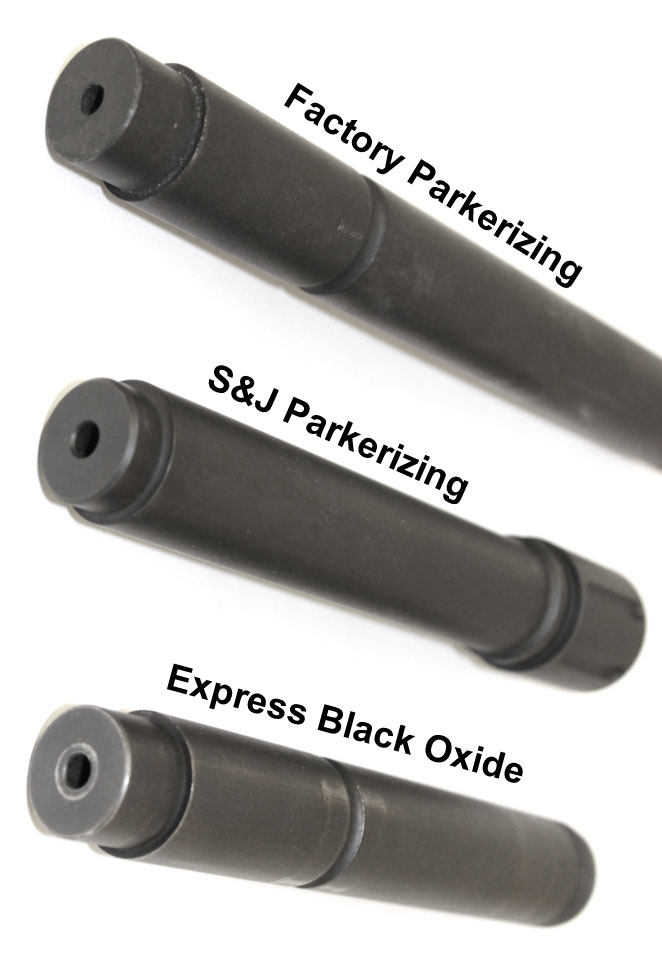
S&J finish compared to factory finishes
If you’re after a different look than flat black/grey, Parkerizing can serve as a good base for firearm paints or coatings like Cerakote, or you can have the extension stripped and refinished to match a blued or nickel-plated 870. Since the S&J extensions are machined from a single piece of homogenous metal, there won’t be any issues with joints being weakened by chemical or physical stripping methods, or new finishes not sticking to certain areas due to differences in material.
Cost:
At the time of this writing, the S&J Hardware MK II +2 extension kit is $99.99 CAD (Canadian dollars) on S&J’s website (www.sjhardware.com). Shipping adds to that, and will vary depending on where the kit is being sent. U.S. customers can purchase this extension and other S&J products from their state-side distributor, S&J Hardware USA (sjhardware.us), without having to pay extra for international shipping from Canada. The S&J MK II +2 kit is currently $95.00 USD (US dollars) from S&J USA. Some other countries have local dealers as well; you can contact S&J for more information. These extensions can also occasionally be found from online 3rd-party sellers, or posted on sites like Ebay. The extension kit may have a slightly lower price tag at these alternate sources, but make sure to take shipping costs & currency conversions into consideration when comparison-shopping.
Generally speaking, expect to spend around $100 (USD) on this kit. This is definitely a premium price level, a good step up from many competing kits, especially the budget-priced options in the $50 ballpark.
Additional Features & Accessories:
Bayonet Lug:
The front end of the S&J +2 extension is intended to fit into the mounting ring in the hilts of M16 bayonets. S&J sells clamp-on rear bayonet lug mounts for use with their extensions, as well as the Remington factory extensions. This rear bayonet lugs clamp to the 1”-diameter section of an extension, and the full-mount also clamps to the barrel to help further secure and reinforce the extension.
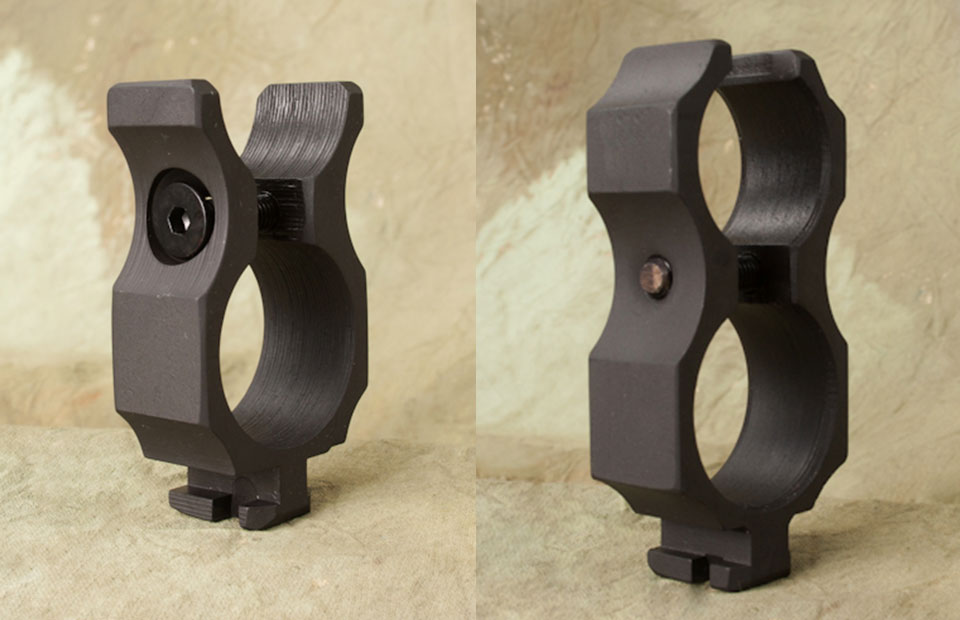
S&J clamp-on rear bayonet lugs
I purchased one of these S&J rear bayonet lugs years ago, and have used it with an OKC M9 bayonet and my factory +2 & +3 extensions with good results. However, the factory extensions are two-piece designs, and I’ve grown fond of the simplicity of single-piece extensions in recent years. The factory extensions also have their sling attachment points located on a bracket that interferes with mounting a bayonet. I was looking forward to having a quality single-piece extension that would mount my bayonet while still providing a sling attachment point.
Unfortunately, the 1”-diameter section of the S&J MK II +2 isn’t quite long enough to securely mount a mil-spec M16 bayonet. Even with the bayonet lug installed as far back as possible, the front of the extension doesn’t even make it all the way through the mounting ring of my M9, leaving the bayonet rattling around on the very tip of the extension rather than being pulled back against the shoulder where it would be more secure. I’m sure I could stab something if I had to with this arrangement, but having over a pound of knife hanging off the front of the gun is bad enough without it wiggling around at the slightest movement, and the rattling is very unappealing. Having the loose knife knocking around under recoil also started to beat up the extension’s finish when I tried it out at the range.
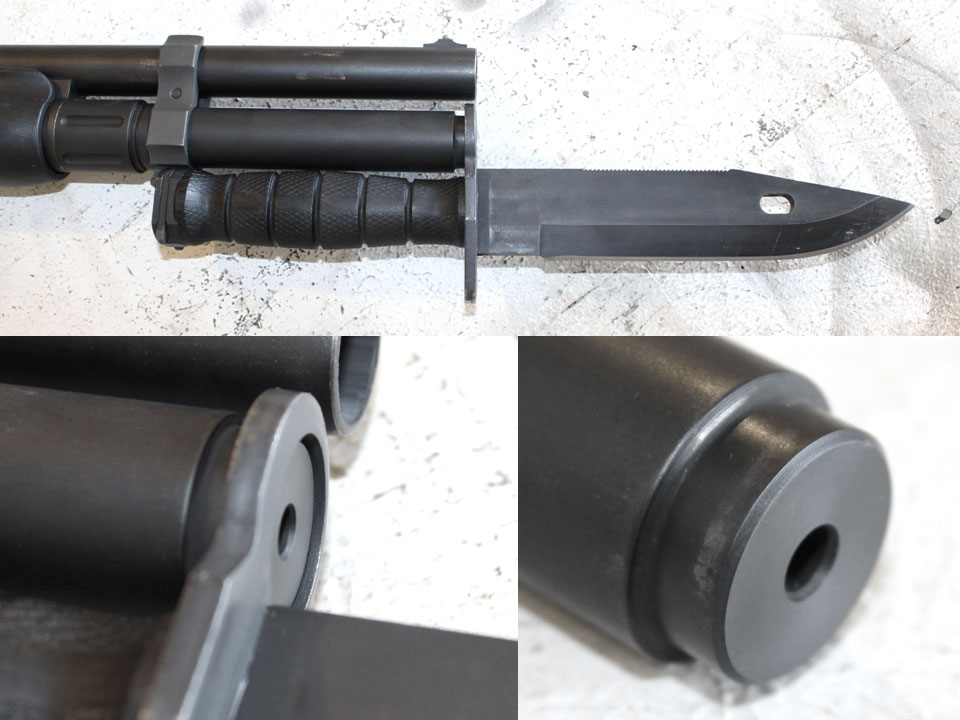
Loose attachment of bayonet with S&J’s rear lug, with finish wear from shooting with the loose bayonet at bottom right.
My OKC M9 is a different knife from the older M7s S&J usually shows in their product images, but I hit up a local military surplus shop with the extension and bayonet lug, and found the same spacing issue with the M7s as well. There are a couple other clamp-on rear bayonet lugs available for the 870, but the extension is too short to work with original military bayonet mounts, or the low-cost light-duty NcStar bayonet mounts. The +3 version may be long enough to work with one or both of these alternatives, but I can’t say for sure.
Being able to mount a bayonet is not terribly practical even for most fighting shotguns, so this really isn’t going to be that big of a deal for most folks. But it is a fun way to add “cool points” to a shotgun, and since the extension and rear lug are both S&J products – and rather expensive products at that – it’s a bit disappointing that they don’t work together very well. Plus, the extension gives up a bit of potential internal capacity in exchange for that stepped-down front end. If the extension’s base was just a quarter-inch shorter, or the mount that much thinner, this wouldn’t be an issue. The +3 version of this extension should mount a bayonet properly, and maybe the +2 will be tweaked in the future, but for now, it’s something to be aware of before you go dropping another hundred bucks on the rear bayonet lug.
Installation:
Before installing an S&J extension kit, you must first remove the gun’s existing magazine cap or extension, spring retainer (if present), magazine spring, and the follower. If the gun has dimples in the end of the magazine tube, these will have to be drilled or pressed out. If the extension is installed without removing those dimples, capacity will be greatly reduced, and feed malfunctions can occur.
If you’re trimming the included spring, or custom-cutting the longer 48” spring for use in this extension, make sure to only remove coils from one end, and install it with the cut end toward the muzzle and the intact end on the follower. The included follower needs the smaller-diameter end coils to properly center this spring on its tail.
If you will be using the sling plate, slide it onto the extension in the desired orientation, and use a pair of snap-ring or needle-nose pliers to spread and place the retaining ring. Make sure that the ring is entirely seated in its groove, and that the sling plate is able to rotate freely in place before proceeding.
To install the extension, ensure that the barrel is properly seated in the receiver, and insert the new follower and extension spring into the magazine tube. Place the extension over the end of the spring, make sure the sling plate (if you’re using it) is properly aligned with the barrel, then thread the extension onto the magazine tube. If you’re using a longer spring and having trouble controlling it, you can insert a thin rod through the hole in the end of the extension to help keep it aligned. Finally, firmly hand-tighten the extension against the barrel guide ring. Test the magazine for capacity and function, making sure to follow all safe gun handling practices.
Function, Reliability, & Common Problems:
The function of any magazine extension revolves around its ability to reliably accept and feed shells.
An at-home test I usually pull out for these reviews involves threading the extension onto a spare magazine tube with varying amounts of thread engagement, inserting the spring and follower, and working the follower back and forth across the internal transition using a 7/8” wooden dowel with one end cut square, and another cut at about a ten-degree angle. The flat end of the dowel duplicates normal loading & feeding, while the angled end serves to cant the follower or shells inside the magazine tube, giving them the best possible chance to snag at the internal gap between the magazine tube and the extension, so that I can find out how severe such a hang-up might be.

Dowel setup for worst-case testing
I mentioned earlier how the extension’s interior hugs closely to the magazine tube where it threads on, and then transitions gradually to its final internal diameter. This design is very effective at guiding the follower and shells as they pass from the mag tube into the extension, and doesn’t give them anything to hang up on. Even during my acid-test with the angled dowel, I simply could not get a loading hang-up to occur no matter how much or how little the extension was threaded onto the mag tube. However, the trade-off to that gradual, elongated throat is that there’s more of an opportunity for shell rims or the follower to catch on the edge of the magazine tube as they move in the other direction during feeding. This is an issue I was able to make happen by slowly moving the follower through the joint with the angled end of the dowel. However, it never happened with the square end of the dowel (probably thanks to the nicely-radiused leading edge of the follower), and live-fire testing with shells was absolutely flawless. I ran many hundreds of rounds through my 870 with this extension installed; factory ammo from a variety of brands as well as many of my handloads. Fold-crimped & roll-crimped shells, light plinkers & heavy hunting magnums, shot & slugs, they all functioned without a single hang-up. Unless you’re trying to run some really sketchy goober-crimped handloads, feed hang-ups really shouldn’t happen; and even if they did manage to occur with some real momentum behind the follower, shooting or even cycling the gun will likely be enough to knock things loose from that very narrow lip.
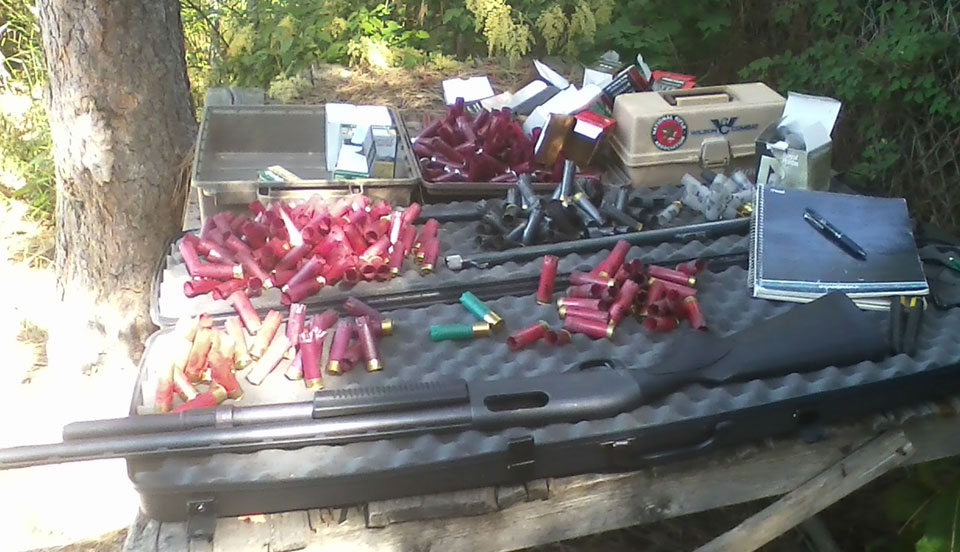
The aftermath of just one of several shooting sessions with the S&J +2
An interesting thing I observed during my testing was that a smaller amount of thread engagement made it harder to induce feed hang-ups with my angled dowel. I did a fair bit of live-fire testing with a push-button QD plate installed under the extension, and it still ran flawlessly. Normally I advise against installing sling plates or other accessories underneath single-piece extensions as it widens the internal gap and tends to encourage malfunctions; but with the S&J +2, it seems that doing so will have no negative effect on function, and in fact might actually help feeding with badly-crimped shells.
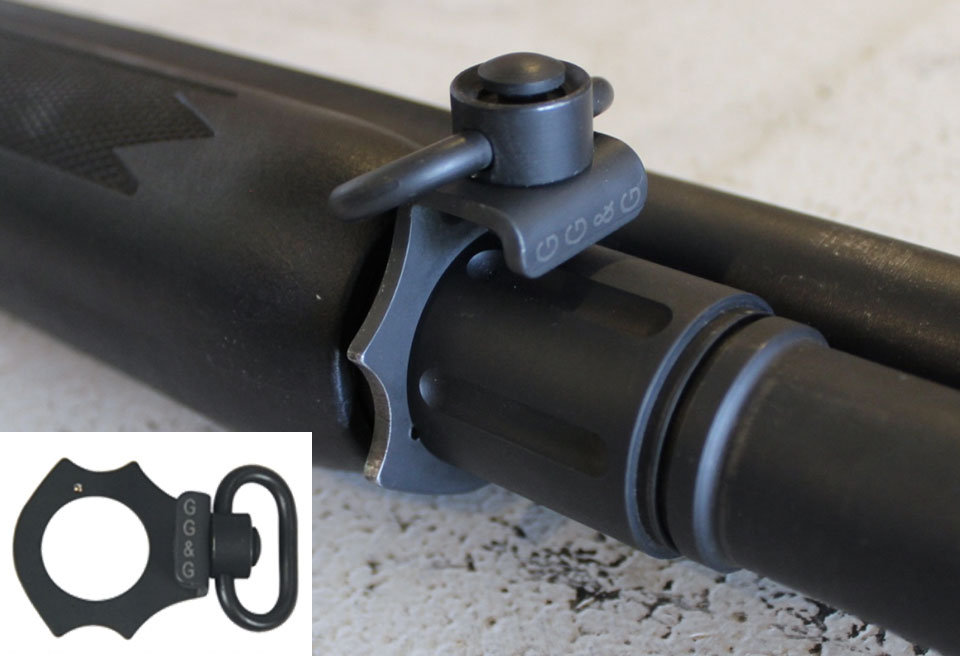
GG&G QD sling plate (with the detent ball removed) installed under the extension
Overall, the S&J MK II +2 handles shells outstandingly reliably. Its mag tube interface is easily the best out of any extension I’ve examined so far, and with this being a single-piece design, I am thoroughly impressed.
The only malfunctions I did observe with the S&J +2 were no-feeds, where the next shell in the magazine would end up on the forward shell latch and fail to feed onto the carrier due to me working the slide very quickly during the recoil event. I’ll point out that this is simply a case of the user outrunning the gun’s ability to feed, and doesn’t really say anything negative about the magazine, apart from the fact that the spring wasn’t able to keep up with that harsh combination of cycle speed & recoil. No-feeds are more likely with hard-kicking loads and a full, extended magazine (the more shells in the magazine, the more inertia the spring must overcome), but a shooter who knows what they’re doing can intentionally trigger no-feed malfunctions in pretty much any extended magazine, even with a heavy spring. However, there is a point where intentionally causing no-feeds requires the user to really focus on yanking the action open as soon as possible after the trigger pull, which doesn’t realistically represent even rapid real-world shooting.
A lot of my testing was with 1 1/8-ounce target loads rated at 1200 FPS, as well as some lighter loads, and I could go through those very quickly without problems using the 28” spring. But with high-velocity 9-pellet 00 buckshot and my heavy recoil test loads (1 ¼ ounces of lead shot at a rated velocity of 1305 FPS), cycling immediately after firing – faster than most folks would work an 870, but within reason for an experienced user trying to shoot very quickly – started to cause no-feeds. Cutting one of S&J’s long 48” springs to 36” and installing that in the +2 rather than the normal 28” spring made the magazine run much better with heavy recoil and very fast cycling. That longer spring was not easy to install in the field without an alignment rod handy though, and the additional coils stopped me from fitting a seventh shell in the tube. Still, if you really want to be able to machine-gun heavy-kicking shells without any worries, the longer 36” spring seems to fit the bill.
I’ll maintain that the included 28” spring is a good length for normal defense & fighting applications, and you should probably give the extension a try with this spring first, since you’re most likely not going to be shooting as rapidly as I was. When actually using the gun for something other than just blowing through ammo, you’re going to want to take a split-second to recover from recoil and re-acquire your aim between shots, and the focus should be on hitting the target rather than yanking the action open as soon as possible after the trigger pull. Heavy loads are usually counter-productive for most roles that call for very rapid shooting, as well. Compared to a longer 36” spring, the 28” spring is not a huge pain to install, it reduces the chances of shell deformation, potentially provides extra capacity, and makes the magazine easier to top off under stress.
Another major reliability consideration is whether or not the extension can stay in place under recoil. The last thing you want to happen – whether it’s during a gunfight or just a day at the range – is for your extension to come loose under recoil. This frees the barrel to move in the receiver, which can mess with headspacing or cause malfunctions. In some cases, a loose extension can work its way completely off the mag tube, launching itself downrange and essentially disabling the gun.
While installing and removing the S&J extension at home, I had noticed that it tended to be rather difficult to remove once tightened down. Getting it loose typically required that I use both hands while holding the gun’s stock between my knees, and sometimes I had to use tools. This was encouraging, but I wasn’t sure the extension would stay that tight under actual recoil – especially since the narrow extension base didn’t always engage the barrel’s mag cap detent properly.
At the range, I tested this extension’s ability to stay in place with three different barrels; one with a magazine cap detent that engaged the extension’s dimples (though just barely), a second that had a detent but didn’t engage the dimples, and a third that had no detent. My procedure with each barrel was as follows: hand-tighten the extension, then shoot rapidly until the barrel was hot, checking frequently to see if the extension had come loose. Then, I loosened the extension, hand-tightened it once more on the hot barrel, and continued shooting while checking frequently for looseness. As mentioned earlier, I also did some shooting with a sling plate (with no detent ball) installed under the extension.
In all cases, the extension stayed firmly in place. In fact, I usually had to use a pair of padded pliers to get the extension loose, though that was partly to avoid burning myself on the hot barrel. As a final test at the end of a couple of shooting sessions, I hand-tightened the extension onto a hot barrel, shot the combo a bunch more, then packed up and headed home with the gun still in that configuration. Hours later, after the barrel had fully cooled in an air-conditioned house, I checked the tightness of the extension. While the extension did come loose with noticeably less effort than usual, it was still adequately tight for good function, and the barrel had remained properly secured.
Needless to say, this is a very impressive result. However S&J designed & machined the extension’s base and threads, they seem to have gotten it right. Firmly hand-tightened onto a cool barrel, I have no worries about this extension shooting loose on me, even without a detent, clamp, or wave washer. You could almost make the argument that it’s too secure, often being difficult to remove by hand in the field once the barrel warms up; but I for one will happily break out the channel-locks if it means I can trust my defensive shotgun to stay together during heavy use or rough handling.
Conclusions:
Pros:
• Sturdy all-steel monolithic construction
• Very refined and well-thought-out design
• Single-piece design is easy & straightforward to install, and does not require a clamp
• Fluted base reduces weight and provides grip for installation & removal
• Vent hole in end cap serves several beneficial functions
• Nicely-done Parkerized finish matches matte-finished 870s well
• High-quality chrome-silicon spring & machined Delrin follower included
• Optional cut-to-length spring available if needed or desired
• Follower incorporates multiple effective safety features
• Follower tail helps to stabilize follower and prevent spring binding
• Extension stays very secure under recoil, even on barrels without mag cap detents
• Standard 1” outer tube diameter is compatible with many clamp-on accessories
• +2 with pretty much any SAAMI-compliant 12ga shells
• +3 with many 2.75” shells without replacing or modifying parts
• Extension length matches common 18.5” barrel length
• Sling plate can be used with any barrel with a muzzle at least 1.5” ahead of the guide ring
• Removable sling plate permits use of custom-made sling plates, or plates from some other extensions
• Sling plate can be oriented vertically or to either side, or left off entirely
• Works reliably with under-cap accessories and handloaded shells
Cons:
• Fairly expensive; over $100 with shipping
• Dimples in base may not engage mag cap detent on all barrels
• S&J’s bayonet mounts cannot be installed far enough back for mil-spec bayonets to mount firmly
• Sling plate will fit loosely with most barrels, no options for QD sling attachment offered
• Extension can sometimes be difficult to remove by hand
The S&J Hardware Mk II +2 extension kit is an outstanding product that exceeded my expectations. There are a few disappointing aspects that I hope S&J will address in future revisions like the loose sling plates, lack of a QD sling plate option, poor mag cap detent engagement, and insufficient space to properly attach a bayonet with S&J’s own rear bayonet lug; but apart from those relatively minor things, this kit just gets so much right. It’s obvious that there was a lot of thought and refinement put into this extension, from major things like the streamlined monolithic construction and extremely reliable internal interface, to little tiny details like the undercut added to the sling plate shoulder to prevent a machining fillet from causing drag and finish wear. And that design is very nicely-executed with good machining and finishing, and paired with quality, well-matched internals. The result has been by far the most reliable, least-finicky extension I’ve ever run on my 870, and its ability to be a +3 with 2.75” shells is just icing on the cake.
Now, you get what you pay for, and this extension doesn’t come cheap. If you’re building on a budget, you can get a durable, reliable +2 capacity boost for a lot less money by selecting something like a Wilson Combat extension kit instead. But if you have some money to spend on your fighting shotgun build, and want something really top-of-the-line and full-featured, I think this is definitely the extension to go for.
Thanks again to Scott Mueller for enabling this review.
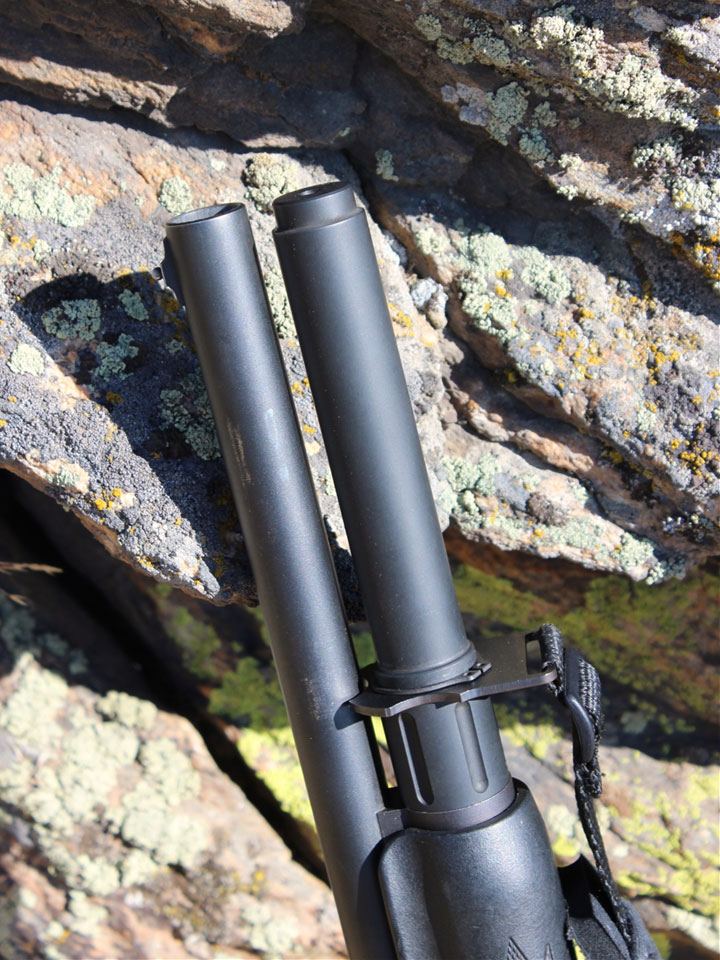
Remington 870 S&J Hardware Extension
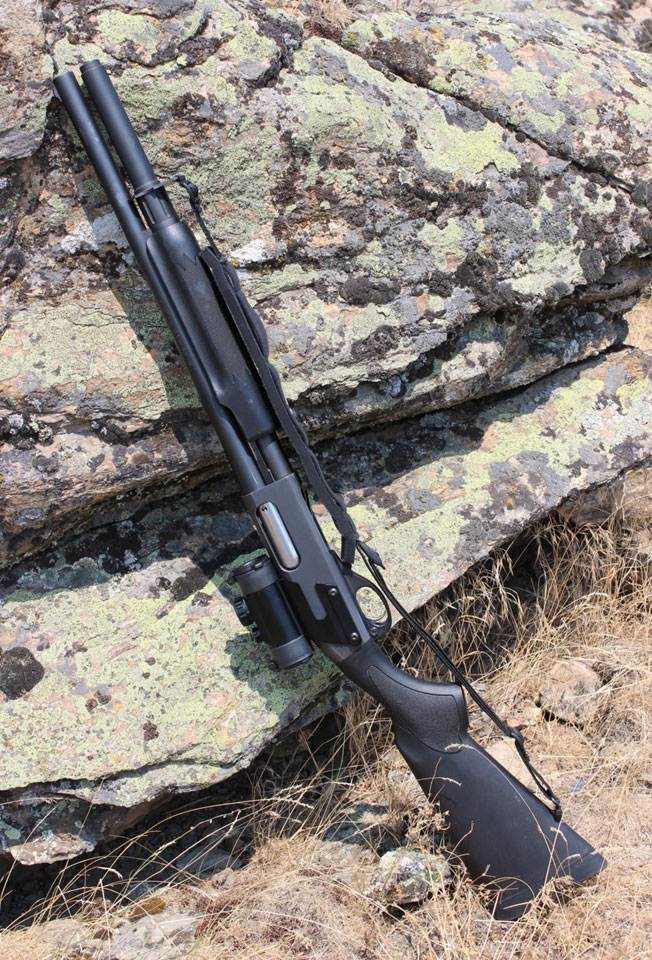
Remington 870 S&J Hardware Extension
-Synchronizor


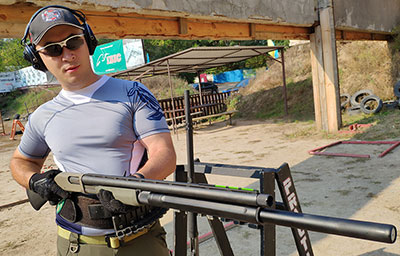
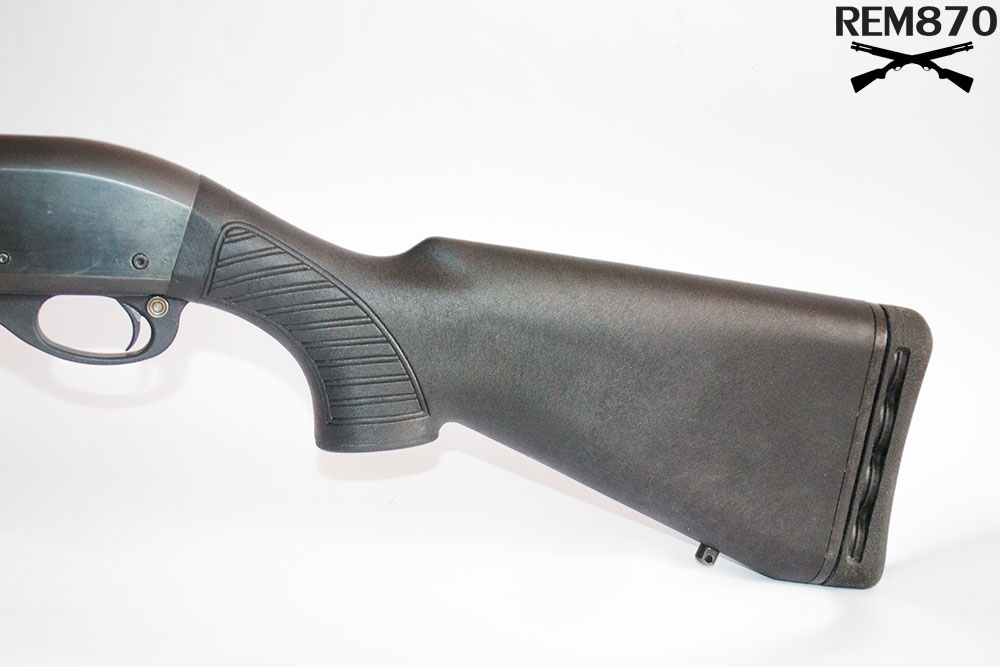
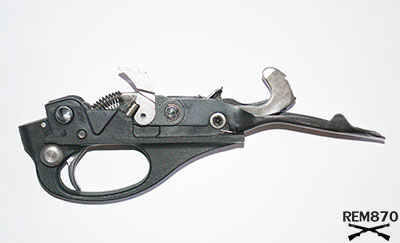
Hello,
I have a Remington 870 with an 18 “barrel and I am looking for an extension magazine tube of such length that it ends up with the upper barrel! … Unfortunately looking on the internet there is none of this (most part end either before or after the upper barrel as they are for 18.5 “) I am aware that Remington does a +2, but that it is out of production … can you help me? tnx for your attention.
Everyone with a TAC 14 -20 Gauge !-
is looking for a +1 extension !
WHY doesn’t someone make one ? (Remington used to, but changed the mag size and stopped.)
And please don’t try to tell me they wouldn’t sell over a million.